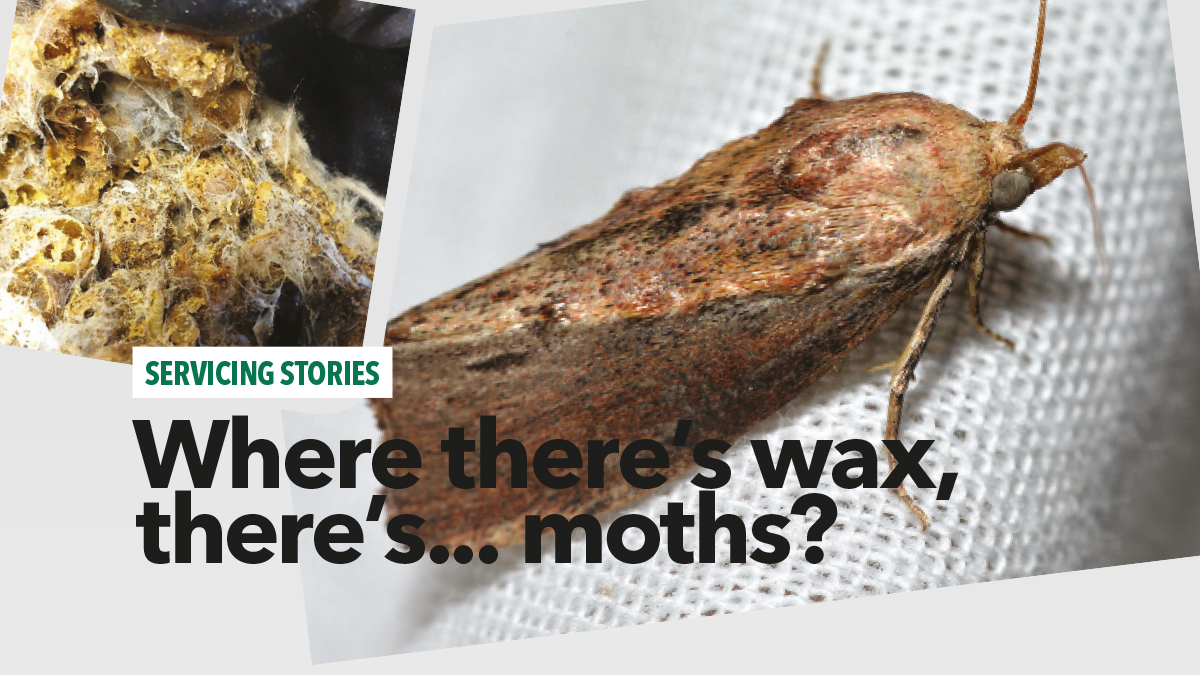Your association | PPC97 November 2019
Ian Furlong from BPCA member company Independent Pest Control & Hygiene Services details his first encounter with wax moths and their symbiotic relationship with the bees in his client’s loft.

An entirely new challenge arose for us recently when we got a call about an infestation of moth in a storage room.
That’s not unusual itself but when we got to the site we identified these as wax moth, a new one for us.
They were literally all over the walls and contaminating soap being stored, so this was a big challenge.
We didn’t know where they had come from or where they could be breeding.
Although considered a minor pest, wax moth larvae can cause a lot of damage and there was the potential for significant financial loss in this instance.
Upon inspecting the roof space during our survey we found an active bees nest, plus two old hives.
These were crawling with moth larvae, living and feeding on the old nests.
This made sense, as wax moths feed on unrefined beeswax, comb honey and bee-collected pollen.
Beekeepers are not particularly fond of them, as they can do incredible damage to colonies.
It was clear these nests were the source of the problem and this was not going to be a small job.
Before we began dealing with the wax moths, we had to look at how we were going to deal with the bees.
Ideally we would have relocated them but unfortunately it was decided that it was not practicable to do so, especially as the wax moths had already weakened the active colony.
Once our technician had treated the bees, we began work on the moth infestation.
We had to take down a double-skinned ceiling, one part of which was timber, the other part ceiling tiles. We then had to remove the loft insulation, which was a two-man job.
It was clear these nests were the source of the problem and this was not going to be a small job.
Ian Furlong
From start to finish it took us 14 days, which included treating the problem and rebuilding the ceiling.
The client was ecstatic; they were up against time with the storage and turnaround of their products.
The wax moth infestation could have been extremely costly for them if the problem wasn’t rectified successfully and efficiently.
And as always, it’s a reminder to never leave any stone unturned when doing your survey and inspect the unusual places that may not be so obvious.
About wax moths
The two types of wax moth are very easy to remember: the greater wax moth and the lesser wax moth.
As with most pests of this nature, it’s the larvae which cause the most damage.
They live as nest parasites in beehives and eat cocoons, pollen and chew through beeswax, earning them their name.
To fully develop into adults, the larvae require access to ‘used’ or dirty brood comb which contains essential proteins for larval development.
The larvae destroy the comb, which causes the stored honey to spill or be contaminated. It can also kill bee larvae or cause honey bee diseases to spread.
Interestingly, they’ve even been known to eat and digest polyethylene plastic, the kind which is used to make carrier bags and bottles.
Rate of growth is entirely dependent on environmental conditions, varying from anywhere between six and 55 days.
The adult wax moths are between 13-15mm long with a 31mm average wingspan, and it’s often the adults that are the first obvious sign of an infestation for many people.
Want to share your first time?
Got an interesting milestone or new pest to share with the sector? Send us your stories and pictures and we’ll share your new-found experience.
hello@bpca.org.uk

Source: PPC97